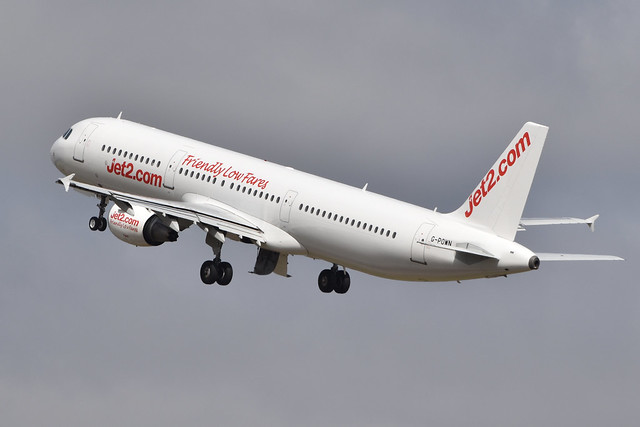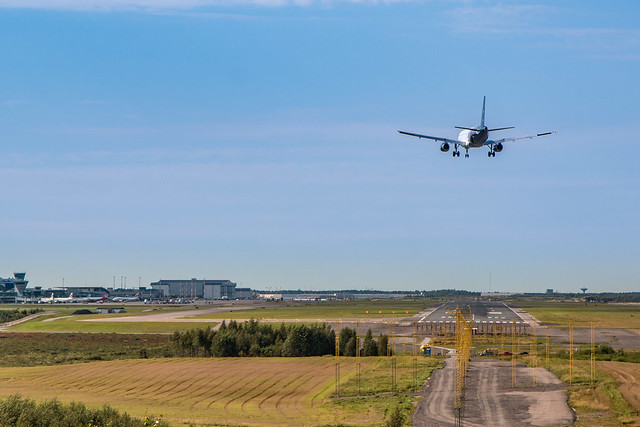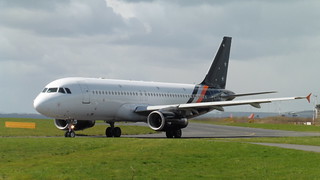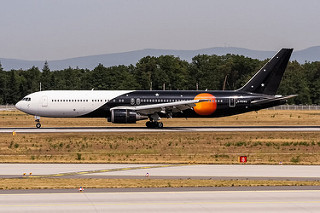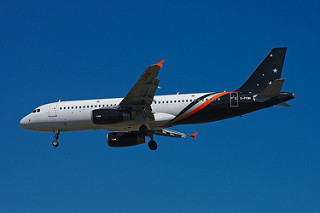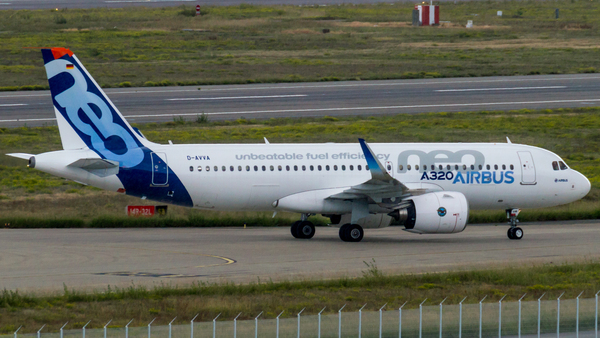Titan A21N at London on Oct 4th 2023, lost 3 windows, stabilizer damage after filming event
Last Update: April 18, 2024 / 16:25:42 GMT/Zulu time
Incident Facts
Date of incident
Oct 4, 2023
Classification
Accident
Airline
Titan Airways
Flight number
AWC-305Y
Departure
London Stansted, United Kingdom
Destination
Orlando, United States
Aircraft Registration
G-OATW
Aircraft Type
Airbus A321-Neo
ICAO Type Designator
A21N
The British AAIB reported it was discovered three cabin windows were missing or loose, there was also damage to the left hand stabilizer, the aircraft sustained substantial damage. The occurrence was rated an accident and is being investigated by the AAIB.
The airline reported on Oct 15th 2023 that there were 21 staff members on board of the aircraft to be repositioned for their next flights. The crew became aware of increased noise and an issue with one of the windows and returned to London according to standard operating procedures without requesting assistance. Following landing it was discovered that the outer panes of three windows were missing. The occurrence was immediately reported and is being investigated.
The aircraft had been in a workshop in Southend for maintenance, repair and overhaul between September 23rd 2023 and October 2nd 2023, performed a positioning flight on Oct 2nd 2023 to Stansted and was on its first revenue flight. The aircraft, tailnumber then G-GBNI, had been used for VIP flights on behalf of the British government until Sep 23rd 2023 and had been returned to Titan.
On Nov 3rd 2023 the AAIB released a Special Bulletin stating:
This Special Bulletin is published to raise awareness of a recent occurrence in which several cabin windows on an Airbus A321 were damaged by high power lights used during a filming event. The damage was discovered after takeoff on the aircraft’s next flight. Work is ongoing with the aircraft manufacturer and operator to fully understand the properties of the lights used and how this risk can be managed in future.
and summarizing the sequence of events:
The aircraft was scheduled to embark on a multi-day charter away from base with a flight crew consisting of three pilots, an engineer, a load master and six cabin crew. The first sector was a positioning flight from London Stansted Airport to Orlando International Airport, Florida. In addition to the 11 crew there were nine passengers on board who were all employees of the tour operator or aircraft operating company. The passengers sat together in the middle of the aircraft just ahead of the overwing exits.
The aircraft departed a few minutes ahead of schedule and took off from Runway 22. Several passengers recalled that after takeoff the aircraft cabin seemed noisier and colder than they were used to. As the aircraft climbed through FL100 and the seatbelt signs were switched off, the loadmaster, who had been seated just in front of the other passengers, walked towards the back of the aircraft. He noticed the increased cabin noise as he approached the overwing exits and his attention was drawn to a cabin window on the left side of the aircraft. He observed that the window seal was flapping in the airflow and the windowpane appeared to have slipped down. He described the cabin noise as ‘loud enough to damage your hearing’.
The loadmaster told the cabin crew and then went to the flight deck to inform the commander.
At this stage the aircraft was climbing past FL130, there were no abnormal indications on the flight deck and the aircraft pressurisation system was operating normally. The flight crew stopped the climb at FL140 and reduced airspeed whilst the engineer and then the third pilot went to look at the window. Having inspected the window, it was agreed the aircraft should return to Stansted. The cabin crew told the passengers to remain seated and keep their seatbelts fastened, and reminded them about the use of oxygen masks if that became necessary.
The cabin was quickly secured and the flight crew initiated a descent, first to FL100 and then to FL90. They established the aircraft in a hold whilst they completed the overweight landing checklist, confirmed landing performance and briefed for the return to Stansted.
The approach and landing on Runway 22 were uneventful. Landing at 1151 hrs, the total flight time was 36 minutes. With the airport RFFS in attendance the aircraft taxied to the apron, where the passengers disembarked normally.
Having parked and shut down, the crew inspected the aircraft from the outside and saw that two cabin windowpanes were missing and a third was dislodged. During the flight the crew had only been aware of an issue with a single windowpane. The cabin had remained pressurised normally throughout the flight.
Previous activity
The day before the occurrence flight the aircraft had been used for filming on the ground, during which external lights had been shone through the cabin windows to give the illusion of a sunrise. The lights were first shone on the right side of the aircraft for approximately five and a half hours, with the light focused on the cabin windows just aft of the overwing exits. The lights were then moved to the left side of the aircraft where they illuminated a similar area on the left side for approximately four hours. Photographs taken during filming showed six sets of flood lights on both sides of the aircraft.
Aircraft examination
Cabin windows
Two window assemblies were missing, and the inner pane and seal from a third window were displaced but partially retained in the airframe. A shattered outer pane was recovered from the entrance to a rapid-exit taxiway during a routine runway inspection after the aircraft landed.
A fourth window protruded from the left side of the fuselage. The four affected windows were adjacent to each other, just aft of the left overwing exit.
Removal of the cabin lining inside the passenger cabin revealed that the window retainers were in good condition and correctly installed. The foam ring material on the back of the cabin liners was found to be melted in the areas adjacent to the windows that were damaged or missing.
Visual examination of the damaged windowpanes revealed that they were deformed and shrunk. The deformed panes no longer formed an effective interface with the rubber seals.
With the AAIB in attendance, the operator removed several cabin liners from the right side of the passenger cabin. This revealed additional thermal damage and window deformation in the area around the overwing emergency exit, but to a lesser extent than the left side of the aircraft.
Horizontal stabiliser
The underside of the left horizontal stabiliser leading edge panel was punctured. Small pieces of acrylic were found in the stabiliser when the panel was removed.
Observations
The windows appear to have sustained thermal damage and distortion because of elevated temperatures while illuminated for approximately four to five and a half hours during filming activity the day before the flight. It is likely that the flood lights were positioned closer than 10 m. Whereas in this case the damage became apparent at around FL100 and the flight was concluded uneventfully, a different level of damage by the same means might have resulted in more serious consequences, especially if window integrity was lost at higher differential pressure.
On Apr 18th 2024 the AAIB released their final report concluding the probable causes of the accident were:
Several cabin window components were lost during the flight. High-intensity lights that were used during a filming event emitted sufficient IR radiation to heat the acrylic windows to a temperature sufficient to soften them leading to distortion and shrinkage. The distorted windows fell out because of vibration or the pressure differential across them as the aircraft climbed after takeoff. The aircraft returned to the departure airport for an uneventful landing.
The AAIB analysed:
Pre-flight inspection
The pre-flight inspection was carried out by the commander. Additionally, as the aircraft was going to be away from its base for several weeks, several engineers were also present prior to departure, completing additional checks of the aircraft. They did not identify any cabin window defects before the flight.
In-flight turn back The aircraft returned to the departure airport because noise levels in the passenger cabin were excessive, and one cabin window was visibly loose. After the aircraft landed, seven parts were missing:
- Three outer windowpanes
- Two inner windowpanes
- Two rubber seals
All the scratch panes remained in place so there was no direct, unrestricted aperture between the passenger cabin and the outside air. There were no symptoms of any pressurisation issues, indicating that for the duration of the flight the amount of air leaking from the passenger cabin remained within the capacity of the pressurisation system.
Broken windowpane recovered from the taxiway
A shattered inner windowpane was recovered from the entrance to a rapid-exit taxiway. The broken remains showed thermal distortion around its periphery, and it was apparent that the windowpane had shrunk. The distortion and shrinkage meant that the windowpane no longer formed an effective interface with the slot in the rubber seal. This made it more likely to fall out due to vibration or the differential air pressure between the passenger cabin and the outside environment.
The aircraft did not pass the rapid-exit after landing, so the inner windowpane fell out when the aircraft took off. For this to happen, the outer windowpane must already have fallen out, but neither it nor the rubber seal were found.
Damaged horizontal stabiliser
The underside of the left horizontal stabiliser leading-edge panel was punctured, and small pieces of acrylic were found inside, indicating that it had been struck by at least one cabin windowpane. The damage had no adverse effects on the controllability of the aircraft.
Windowpane damage
The day before the occurrence flight both sides of the aircraft were illuminated by six halogen light arrays with a combined power output of approximately 72,000 W. The lights were positioned closer to the aircraft than the minimum recommended distance and the acrylic windows absorbed IR radiation, with very limited ability to dissipate this energy into the surrounding structure or air. As time progressed, the temperature of the acrylic increased to the point that the material softened and started to deform and shrink. The window retainers apply a compressive force around the periphery so, as the acrylic softened, this force may have exacerbated the distortion. The temperature that the acrylic achieved is unknown, but two of the windowpanes had reduced in size by approximately 6%. The manufacturing process specification indicates a maximum of 10% shrinkage at 110°C so it is likely that these windows achieved a temperature that was approaching this value. This is beyond the aircraft’s certified operating limits.
Previous occurrences
There have been at least four previous occurrences (one Airbus A321 and three Boeing 787) where acrylic cabin windows have been damaged by high-intensity lights during filming. The damage was identified and repaired before flight, so it is likely that it was more obvious than G-OATW.
In 2020, Boeing issued a Fleet Team Digest article citing three events where damage was caused by the absorption of IR energy from high-intensity lights. The article was applicable to Boeing 787 operators, but this investigation shows that other aircraft with acrylic windows could also be similarly affected.
Safety action
In response to this accident, Airbus published an In Service Information document to highlight the risk of acrylic window damage when using high-intensity lights. The document is available to all Airbus customers. Airbus also published an article in their online Safety First magazine.
EASA published a Safety Information Bulletin to highlight the risk of damage when using high-intensity lights close to an aircraft.
Safety management of filming
The lights were used closer to the aircraft than recommended in their datasheet. It is not known whether the lights could have been placed further away and still achieve the desired look for the filming. The gaffer was responsible for setting up the lighting but was not aware of the datasheet prior to the investigation. According to the gaffer, equipment datasheets are not routinely consulted when hiring equipment and the selection and safe use of such equipment relies on experience rather than data and standard procedures. There are no formal qualifications or training required to undertake the gaffer role and the lighting hire company did not place any restrictions or give any information on how it could be used. Overall, this indicates that an aircraft operator should not rely on a video production company and its contractors to ensure aircraft safety.
The filming on G-OATW was risk assessed by the video production company in collaboration with the other involved parties. As the process was led by the film production company, the focus was on the safety of personnel during filming. However, the potential to damage the aircraft cosmetically or for people to access the flight deck and interfere with controls was identified during the risk assessment or planning and it was managed with the use of engineering supervision during the filming. No one involved anticipated that the lights could damage the acrylic windows. Following this event, the operator reminded the department responsible for the filming of the need to use its own risk assessment process for such activities.
Other operators were consulted after the publication of the AAIB Special Bulletin about this event and provided information about their own approach. Most stated they would do their own assessment with varying degrees of formality. None of them, except for the operator who had suffered previous damage from the same cause, had previously anticipated this type of damage in their assessments. This would require specific technical knowledge of the lighting equipment and the properties of the windows. There could be benefit in using more technical evidence, such as lighting datasheets, as part of the risk assessment process when hazardous equipment is going to be used on or near an aircraft.
At least four other operators have previously encountered the same issue, but the window damage was identified and repaired before flight, so the events were not independently investigated. Boeing acted to inform other Boeing 787 operators about the events they were aware of but the learning from other events was not spread within the aviation or filming communities. A problem like this is hard to anticipate because it is caused by equipment and material properties that are not visible and information about them is not easily accessible. Openly sharing safety related learning, even if the consequences do not reach the threshold for independent investigation, increases the ability of the aviation community to manage risks.
Incident Facts
Date of incident
Oct 4, 2023
Classification
Accident
Airline
Titan Airways
Flight number
AWC-305Y
Departure
London Stansted, United Kingdom
Destination
Orlando, United States
Aircraft Registration
G-OATW
Aircraft Type
Airbus A321-Neo
ICAO Type Designator
A21N
This article is published under license from Avherald.com. © of text by Avherald.com.
Article source
You can read 2 more free articles without a subscription.
Subscribe now and continue reading without any limits!
Read unlimited articles and receive our daily update briefing. Gain better insights into what is happening in commercial aviation safety.
Send tip
Support AeroInside by sending a small tip amount.
Related articles
Titan A321 at London on Feb 26th 2020, left engine surged, engine stall indications for right engine
A Titan Airways Airbus A321-200, registration G-POWN performing a positioning flight AWC-411W from London Gatwick,EN to London Stansted,EN (UK), was…
Titan A320 near Bordeaux on Jul 5th 2019, engine stall
A Titan Airways Airbus A320-200 on behalf of TUI Airways, registration G-POWM performing flight BY-517 from Marrakesh (Morocco) to London Gatwick,EN…
Titan A320 at Banjul on Apr 26th 2019, bird strike
A Titan Airways Airbus A320-200, registration G-POWK performing flight ZT-792 from Banjul (Gambia) to London Gatwick,EN (UK), was climbing out of…
Titan B763 near Amsterdam on Mar 19th 2017, loss of cabin pressure
A Titan Airways Boeing 767-300, registration G-POWD performing charter flight ZT-1941 (callsign AWC-941) from London Stansted,EN (UK) to Rzeszow…
Titan A320 near Venice on Oct 9th 2015, captain incapacitated
An Titan Airways Airbus A320-200 on behalf of Easyjet, registration G-POWI performing flight U2-5461 from London Gatwick,EN (UK) to Heraklion…
Newest articles
TAP A20N at Lisbon on Nov 14th 2025, lightning strike
A TAP Air Portugal Airbus A320-200N, registration CS-TVP performing flight TP-862 from Lisbon (Portugal) to Venice (Italy), was climbing out of…
UPS MD11 at Louisville on Nov 4th 2025, burst into flames on takeoff
A UPS United Parcel Service McDonnell Douglas MD-11, registration N259UP performing flight 5X-2976 from Louisville,KY to Honolulu,HI (USA) with 3…
Subscribe today
Are you researching aviation incidents? Get access to AeroInside Insights, unlimited read access and receive the daily newsletter.
Pick your plan and subscribePartner

ELITE Simulation Solutions is a leading global provider of Flight Simulation Training Devices, IFR training software as well as flight controls and related services. Find out more.
SafetyScan Pro provides streamlined access to thousands of aviation accident reports. Tailored for your safety management efforts. Book your demo today
AeroInside Blog
Popular aircraft
Airbus A320Boeing 737-800
Boeing 737-800 MAX
Popular airlines
American AirlinesUnited
Delta
Air Canada
Lufthansa
British Airways
